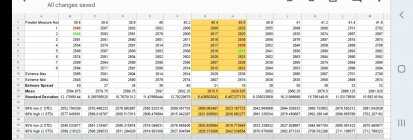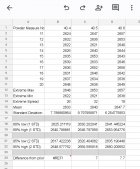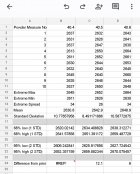You are using an out of date browser. It may not display this or other websites correctly.
You should upgrade or use an alternative browser.
You should upgrade or use an alternative browser.
Load Development Using Chrono Velocity Ladder
- Thread starter CharlieNC
- Start date
4xforfun
Gold $$ Contributor
Once again ,,I didn't read through all of the posts, so if this came up...sorry
I shoot 3 1 shot ladders at a time. Start low and go up...start up and go back down...and then back up again. I start with a warm, foweled bbl and keep it warm. I wait a bit between every shot....depending on what I am shooting. Also......I shoot mine at 600 or 1000 yards. I have never used a chrono...but just bought a new Lab Radar....so....
Tod
I shoot 3 1 shot ladders at a time. Start low and go up...start up and go back down...and then back up again. I start with a warm, foweled bbl and keep it warm. I wait a bit between every shot....depending on what I am shooting. Also......I shoot mine at 600 or 1000 yards. I have never used a chrono...but just bought a new Lab Radar....so....
Tod
CharlieNC,
To your original question, I have put together a simulation to show what happens with single shot and three shot ladders. This simulation assumes that the you have the ability to load a large population of rounds of a particular charge to a standard deviation of 10 fps and a normal velocity distribution. Loading any individual round is equivalent to loading a large population and randomly selecting a round. I have assumed a 308 cartridge with 43 grains of powder yielding a average velocity of 2600 fps and a powder velocity increment of 60 fps/grain. Each chart shows the population means and two different random sample runs. The samples runs are just two of an almost infinite number of possibilities. Increasing the number of samples at each charge weight decreases the probably of finding a flat spot but it cannot eliminate the possibility of it occurring. I apologize for the terminology in the Three Sample legend. It should read the same as the Single Sample legend.
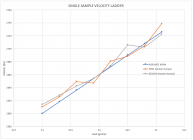
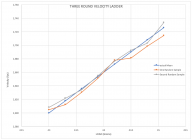
To your original question, I have put together a simulation to show what happens with single shot and three shot ladders. This simulation assumes that the you have the ability to load a large population of rounds of a particular charge to a standard deviation of 10 fps and a normal velocity distribution. Loading any individual round is equivalent to loading a large population and randomly selecting a round. I have assumed a 308 cartridge with 43 grains of powder yielding a average velocity of 2600 fps and a powder velocity increment of 60 fps/grain. Each chart shows the population means and two different random sample runs. The samples runs are just two of an almost infinite number of possibilities. Increasing the number of samples at each charge weight decreases the probably of finding a flat spot but it cannot eliminate the possibility of it occurring. I apologize for the terminology in the Three Sample legend. It should read the same as the Single Sample legend.


I could do it at 200 but it’s a little trickier staying on top of conditions and calling your shots. Besides I can see everything I need to see at 100.I assume that these groups were shoot at 100? If you did this test at say 200 yards wouldn't it be easier to observe a more pronounced variation between the various charge weights?
Bart
CharlieNC
Gold $$ Contributor
CharlieNC,
To your original question, I have put together a simulation to show what happens with single shot and three shot ladders. This simulation assumes that the you have the ability to load a large population of rounds of a particular charge to a standard deviation of 10 fps and a normal velocity distribution. Loading any individual round is equivalent to loading a large population and randomly selecting a round. I have assumed a 308 cartridge with 43 grains of powder yielding a average velocity of 2600 fps and a powder velocity increment of 60 fps/grain. Each chart shows the population means and two different random sample runs. The samples runs are just two of an almost infinite number of possibilities. Increasing the number of samples at each charge weight decreases the probably of finding a flat spot but it cannot eliminate the possibility of it occurring. I apologize for the terminology in the Three Sample legend. It should read the same as the Single Sample legend.
View attachment 1356723View attachment 1356724
Exactly! While I do not believe such a flat spot exists, I am open to the possibility and would find it most interesting if it could be shown with adequate sample size to make it beliveable.
lets just start with your basic assumption is wrong.
people still shoot single shot ladders for load development.
shooting a lot of shots is contrary to the intent...find a load without spending an arm and a leg or wearing out a bbl
your goal of a large sample set is contrary to shooting..the bbl would be shot out before the test was done and the data useless at that point.
the basic error is that it is SHOOTING not science
bye done
people still shoot single shot ladders for load development.
shooting a lot of shots is contrary to the intent...find a load without spending an arm and a leg or wearing out a bbl
your goal of a large sample set is contrary to shooting..the bbl would be shot out before the test was done and the data useless at that point.
the basic error is that it is SHOOTING not science
bye done
LVLAaron
Gold $$ Contributor
Ladder test works for me. I know 44.5 is my load. I've played with this a bunch of different ways. Target ladder test, velocity ladder test, groups with unknown speed....
I can always go back and verify with the ladder test... It works for me. I know some people will poop on it... but it works for me. After this I'll test seating depth, and then the tuner.
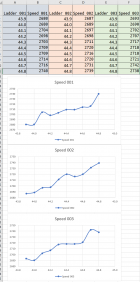
I can always go back and verify with the ladder test... It works for me. I know some people will poop on it... but it works for me. After this I'll test seating depth, and then the tuner.

Ladder test works for me. I know 44.5 is my load. I've played with this a bunch of different ways. Target ladder test, velocity ladder test, groups with unknown speed....
I can always go back and verify with the ladder test... It works for me. I know some people will poop on it... but it works for me. After this I'll test seating depth, and then the tuner.
View attachment 1356811
I never intended to imply that you can't use the ladder test. Any method that results in an actual accurate load works. I have personally never seen anyone post a retest though that provided the same results. The fact remains that a one shot measurement used to detect a flat spot is highly unlikely to find an actual flat spot and that the test method actually creates flat spots. Your test over three ladders does seem to indicate that a flat spot exists but also shows some conflicting data (44.7 and 44.8) but to actually accept that hypothesis you would need to test over different loading sessions and different test days. I could get into some other issues related to chronograph accuracy and repeatability along with load increment that are affecting your results but that is getting too deep.
My personal opinion is that you can actually pick a load and find a seating depth that will yield an accurate load. As of about a year ago that was Scott Satterlee's approach. He had apparently abandoned the ladder approach. I personally do not use a chronograph for load development, only for refining the loading process and determining the approximate velocity once I have a load.
Nope. Not wrong and I understand that people will use it. Nor did I say that using a larger sample will give the correct intended result. The analysis was intended to show the fallacy of using a single shot to determine the actual velocity response of a given load and that the method creates false flat spots.I never intended to imply that you can't use the ladder test. I have personally never seen anyone post a retest though that provided the same results. The fact remains that a one shot measurement used to detect a flat spot is highly unlikely to find an actual flat spot.
My personal opinion is that you can actually pick a load and find a seating depth that will yield an accurate load. As of about a year ago that was Scott Satterlee's approach. He had apparently abandoned the ladder approach. I personally do not use a chronograph for load development, only for refining the loading process and determining the approximate velocity.
lets just start with your basic assumption is wrong.
people still shoot single shot ladders for load development.
shooting a lot of shots is contrary to the intent...find a load without spending an arm and a leg or wearing out a bbl
your goal of a large sample set is contrary to shooting..the bbl would be shot out before the test was done and the data useless at that point.
the basic error is that it is SHOOTING not science
bye done
LVLAaron
Gold $$ Contributor
Your test over three ladders does seem to indicate that a flat spot exists but also shows some conflicting data (44.7 and 44.8)
That's kind of the point. Things aren't "stable" at that load.
For the chrono data, here is some data I used 5 years ago when I was using chrono to pick my load. Looking back on the data and subsequent tests in other barrels did not seem to give me an answer that was usable as I kept testing.
In other words, as I kept testing...more data meant more muddiness. I even eventually tested by seating pressure and would continually get conflating numbers.
The 40.4, 40.5, 40.6 were all shot on the same day. This was with a Ruger Precision Rifle...so it wasn't a top rig. But I think the same premise applies
In other words, as I kept testing...more data meant more muddiness. I even eventually tested by seating pressure and would continually get conflating numbers.
The 40.4, 40.5, 40.6 were all shot on the same day. This was with a Ruger Precision Rifle...so it wasn't a top rig. But I think the same premise applies
Attachments
Last edited:
Orr89rocz
Silver $$ Contributor
Im a novice compared to some of you but i always see flat spots with my rifles doing chrono ladders.(except in my 458 win mag i dont load it that way lol) However i shoot 2 of each atleast, since the covid shortage lol usually 3 because i’ll also get the group data at a starting seating depth i’ll use later.
My 300 wsm in half grain increments found a flat spot where the next half grain had no or little velocity gain. When shooting 3, sometimes you can tell you are getting close as you move up because two out of 3 may be closer in velocity and then the next half grain up all 3 will be very close if not much spread at all. Half grain too much you’ll see one or two of the shots gain velocity above the “node”
When i find it i do seating. I chrono those too and 10-25 shots later depending on what happens i start to get good data on spread. Usually find a good group and at 1000+ i shoot for fun, good low es and sd make it consistent.
My 257 roberts did the same thing. Found a node. With two diff bullets and two diff powders. Then did seating and found a good load.
I did a 300 win with 2 shots of each charge and found a good low es sd charge but for whatever reason i didnt find a super accurate load. Accurate enough for long range 600 yrd work but kinda expected better. About half moa at best. But the box of bullets i shot, chronod alot of them and velocity was pretty consistent with occassional outliers, which may be components related or a bad reading. Not sure
My 300 wsm in half grain increments found a flat spot where the next half grain had no or little velocity gain. When shooting 3, sometimes you can tell you are getting close as you move up because two out of 3 may be closer in velocity and then the next half grain up all 3 will be very close if not much spread at all. Half grain too much you’ll see one or two of the shots gain velocity above the “node”
When i find it i do seating. I chrono those too and 10-25 shots later depending on what happens i start to get good data on spread. Usually find a good group and at 1000+ i shoot for fun, good low es and sd make it consistent.
My 257 roberts did the same thing. Found a node. With two diff bullets and two diff powders. Then did seating and found a good load.
I did a 300 win with 2 shots of each charge and found a good low es sd charge but for whatever reason i didnt find a super accurate load. Accurate enough for long range 600 yrd work but kinda expected better. About half moa at best. But the box of bullets i shot, chronod alot of them and velocity was pretty consistent with occassional outliers, which may be components related or a bad reading. Not sure
jackieschmidt
Gold $$ Contributor
There is quite a bit of difference in working up a load in a 100/200/300 yard Benchrest Rifle that a 600+ yard Benchrest Rifle. As Bart noted, SD and ES are secondary. Agging capability trumps everything. Velocity spread and agging capability are often two separate items.
Also, I never trust any load combination until it will stack 5 shots below that magic .200 standard at least three times. If you are shooting over flags and have a good handle on conditions, you have to be able to account for every shot on the paper. That means you have to have total confidence in everything involved in your combination.
in Short range, I do not shoot ladders. I load at the range 100% of the time, where I can instantly change something to see how it affects the tune.
I have two calibers I shoot in serious competition. My 6PPC and my 30BR. I only use two brands of barrels, Kriegers and Bartliens. I know what works in these barrels. I know exactly what velocity they produce with a proven load.
All that being said, I kinda go by the theory that if you have a proven combination, and for some reason you can’t fine tune a new barrel in to shoot it, then you have to decide how many great bullets, how many grains of expensive powder, and how many primers are you going to waste trying to make it competitive.
Sure, you might accidentally stumble onto something it likes. But odds are, it‘s not going to stay there.
then you have to decide how in love you are with it.
Also, I never trust any load combination until it will stack 5 shots below that magic .200 standard at least three times. If you are shooting over flags and have a good handle on conditions, you have to be able to account for every shot on the paper. That means you have to have total confidence in everything involved in your combination.
in Short range, I do not shoot ladders. I load at the range 100% of the time, where I can instantly change something to see how it affects the tune.
I have two calibers I shoot in serious competition. My 6PPC and my 30BR. I only use two brands of barrels, Kriegers and Bartliens. I know what works in these barrels. I know exactly what velocity they produce with a proven load.
All that being said, I kinda go by the theory that if you have a proven combination, and for some reason you can’t fine tune a new barrel in to shoot it, then you have to decide how many great bullets, how many grains of expensive powder, and how many primers are you going to waste trying to make it competitive.
Sure, you might accidentally stumble onto something it likes. But odds are, it‘s not going to stay there.
then you have to decide how in love you are with it.
Last edited:
I just did load development for new 6.5-06AI and 300WM hunting rifles. Both using ladders by .3gr to pressure, one shot each charge. Both yielded a "flat spot" in velocity. But more importantly, in both cases, this flat spot resulted in 3 consecutive shots landing at nearly the same vertical and an inch overall group at 300 yards. Subsequent 3-shot groups at those three charges for each rifle yielded a ~1/3 MOA group at one of the charges at 100 yards. In both cases, the velocities from the 3-shot group were consistent with the single shot at 300 for each charge. None of the groups sucked or were unacceptable.
Most importantly, I'd demonstrated...for these HUNTING rifles...that within that charge range they were both accurate.
For the 300WM, interesting enough, all of the shots up to the "flat spot" landed in a 4in group with little vertical. However above the flat spot charge, the shots started climbing up the paper; .6gr later they were a full MOA over the flat spot impact. It wasn't heat as I was giving 10min cooling between shots so the barrel was not getting hot.
I'm a scientist, I get the statistics argument. But with many rifles by the time you make the statistics work you've worn the barrel and may need to re-work your load. However at the end of the day I care that when I take a shot I'm confident in my rifle and my ammunition. This gives me confidence, and has worked over and over for many rifles, so I continue to do it. I know, perhaps not trendy, but I still neck size for some rifles so there's that.
Most importantly, I'd demonstrated...for these HUNTING rifles...that within that charge range they were both accurate.
For the 300WM, interesting enough, all of the shots up to the "flat spot" landed in a 4in group with little vertical. However above the flat spot charge, the shots started climbing up the paper; .6gr later they were a full MOA over the flat spot impact. It wasn't heat as I was giving 10min cooling between shots so the barrel was not getting hot.
I'm a scientist, I get the statistics argument. But with many rifles by the time you make the statistics work you've worn the barrel and may need to re-work your load. However at the end of the day I care that when I take a shot I'm confident in my rifle and my ammunition. This gives me confidence, and has worked over and over for many rifles, so I continue to do it. I know, perhaps not trendy, but I still neck size for some rifles so there's that.
Interesting so the what if? New barrels tend to speed up early in the round count, if you find a flat spot does the velocity stay flat(just faster) or is the whole test out with the bathwater?
There is quite a bit of difference in working up a load in a 100/200/300 yard Benchrest Rifle that a 600+ yard Benchrest Rifle. As Bart noted, SD and ES are secondary. Agging capability trumps everything. Velocity spread and agging capability are often two separate items.
Also, I never trust any load combination until it will stack 5 shots below that magic .200 standard at least three times. If you are shooting over flags and have a good handle on conditions, you have to be able to account for every shot on the paper. That means you have to have total confidence in everything involved in your combination.
in Short range, I do not shoot ladders. I load at the range 100% of the time, where I can instantly change something to see how it affects the tune.
I have two calibers I shoot in serious competition. My 6PPC and my 30BR. I only use two brands of barrels, Kriegers and Bartliens. I know what works in these barrels. I know exactly what velocity they produce with a proven load.
All that being said, I kinda go by the theory that if you have a proven combination, and for some reason you can’t fine tune a new barrel in to shoot it, then you have to decide how many great bullets, how many grains of expensive powder, and how many primers are you going to waste trying to make it competitive.
Sure, you might accidentally stumble onto something it likes. But odds are, it‘s not going to stay there.
then you have to decide how in love you are with it.
ES and SD are secondary--or even tertiary--for 1000 yd BR as well as short range. Very often, if not most of the time, best ES/SD do not correspond to the smallest groups.
CharlieNC
Gold $$ Contributor
ES and SD are secondary--or even tertiary--for 1000 yd BR as well as short range. Very often, if not most of the time, best ES/SD do not correspond to the smallest groups.
This seems to be the predominant conclusion by those who have tested load optimization extensively, after evaluating many options. Looking at the the Chrono single shot ladder as a short cut, single shot long the target is more informative!
I am in "Doom" camp. The so called "flat velocity spot" on ladder is total Rubbish approach to load development.
Here is my take:
In physics, there is no free lunch. In closed thermodynamics systems such as the internal ballistic solution, the goal is to get:
1) A very low MV SD vs powder charge load
2) Small groups vs powder charge load
3) MV velocity stability vs powder temperature
4) MV velocity stability vs small powder variations
5) MV velocity stability vs primer choice
6) Low vertical dispersion at very long and extremely long ranges vs bullet selection
First, let us solve the issues related to goals that we can control pretty easily. More specifically, 3) 4) 5) and 6)
3) Use temperature stable powder such as IMR endurance, Hodgdon Extreme Powder, etc. There are many online tests that you can search for and find what powders are the most temperature stable (e.g., H4350)
4) Measure each powder drop to less than 0.1gr accuracy. It is easy to get to 0.02gr (1 extruded kernel) which is worth 0.3fps out of typical load
5) Make a small ladder test and see if the selected primers would produce a smoothly rising curve, if not, do not use those primers.
6) Use VLD bullets with very low variations in G7 BC. For example, pick VLD bullets with less than 1% variation in G7 BC. Now, here we finished the goals that are virtually 100% influenced by the components
Now, let us focus on the loading for the node. What is the node after all?
Optimum Barrel Time, OBT node: It is the node (with respect to time) where the bullet leaves the barrel when the muzzle is subjected to the least dilation/contraction due to the powder explosion shock waves
Optimum Charge Weight, OCW node: it is the node (with respect to time) where the bullet leaves the barrel when the muzzle is pointing to the same point of impact due to the powder explosion shock waves
Optimum Feet per sec, OFPS node: it is the node (with respect to time) where the bullet leaves the barrel with the minimum SD of MV due to the powder explosion shock waves keeping all parameters the same, changing the powder charge can change the MV and inversely the actual barrel time of the bullet
Note: OFPS is my theory why MV SD would shrink for the same powder but by just changing the powder charge. What node are we after?
Goal 1) is solved with OFPS node, a theory I introduced in September 2018.
Goal 2) is solved with OBT time. The good news, OBT is numerically computed. With the advancement of very accurate radar-based chronographs and internal ballistic solvers, the OBT charge load can be accurately calculated. I had success doing that for a few competitive shooters as proof of concept.
How about Goal 1) the best way to find it in my experience is to shoot a group of 3-5 shots in a ladder test such as the 6.5group spreadsheet test and find the lowest MV SD The bad news is OBT node (the smallest group) and OFPS node (the lowest MV SD) don't overlap. Remember, in Physics, there is no free lunch. The good news is both nodes are adjacent and in my experience, if you find the OBT node, the OFPS node is the next step load in the ladder. As groups shrink, MV SD will increase and vice versa. So, the best is to find a compromise load between OBT/OFPS nodes that works for the shooter.
Here is my take:
In physics, there is no free lunch. In closed thermodynamics systems such as the internal ballistic solution, the goal is to get:
1) A very low MV SD vs powder charge load
2) Small groups vs powder charge load
3) MV velocity stability vs powder temperature
4) MV velocity stability vs small powder variations
5) MV velocity stability vs primer choice
6) Low vertical dispersion at very long and extremely long ranges vs bullet selection
First, let us solve the issues related to goals that we can control pretty easily. More specifically, 3) 4) 5) and 6)
3) Use temperature stable powder such as IMR endurance, Hodgdon Extreme Powder, etc. There are many online tests that you can search for and find what powders are the most temperature stable (e.g., H4350)
4) Measure each powder drop to less than 0.1gr accuracy. It is easy to get to 0.02gr (1 extruded kernel) which is worth 0.3fps out of typical load
5) Make a small ladder test and see if the selected primers would produce a smoothly rising curve, if not, do not use those primers.
6) Use VLD bullets with very low variations in G7 BC. For example, pick VLD bullets with less than 1% variation in G7 BC. Now, here we finished the goals that are virtually 100% influenced by the components
Now, let us focus on the loading for the node. What is the node after all?
Optimum Barrel Time, OBT node: It is the node (with respect to time) where the bullet leaves the barrel when the muzzle is subjected to the least dilation/contraction due to the powder explosion shock waves
Optimum Charge Weight, OCW node: it is the node (with respect to time) where the bullet leaves the barrel when the muzzle is pointing to the same point of impact due to the powder explosion shock waves
Optimum Feet per sec, OFPS node: it is the node (with respect to time) where the bullet leaves the barrel with the minimum SD of MV due to the powder explosion shock waves keeping all parameters the same, changing the powder charge can change the MV and inversely the actual barrel time of the bullet
Note: OFPS is my theory why MV SD would shrink for the same powder but by just changing the powder charge. What node are we after?
Goal 1) is solved with OFPS node, a theory I introduced in September 2018.
Goal 2) is solved with OBT time. The good news, OBT is numerically computed. With the advancement of very accurate radar-based chronographs and internal ballistic solvers, the OBT charge load can be accurately calculated. I had success doing that for a few competitive shooters as proof of concept.
How about Goal 1) the best way to find it in my experience is to shoot a group of 3-5 shots in a ladder test such as the 6.5group spreadsheet test and find the lowest MV SD The bad news is OBT node (the smallest group) and OFPS node (the lowest MV SD) don't overlap. Remember, in Physics, there is no free lunch. The good news is both nodes are adjacent and in my experience, if you find the OBT node, the OFPS node is the next step load in the ladder. As groups shrink, MV SD will increase and vice versa. So, the best is to find a compromise load between OBT/OFPS nodes that works for the shooter.
Orr89rocz
Silver $$ Contributor
thats so hard to wrap my head around. If you look at ballistics apps at 1000 yrds for my 300 wsm and 208 berger, 2870 fps drops 254 inch. 2885 drops 250.9. 2900 drops 247.8. So in 15 fps spread can be 3” vertical, 30 can be 6” basically. And thats assuming consistent BC. Its hard to think a larger spread would be tighter group based on drops alone, but i guess point of impact is affected by barrel harmonics too and whatever else.ES and SD are secondary--or even tertiary--for 1000 yd BR as well as short range. Very often, if not most of the time, best ES/SD do not correspond to the smallest groups.
thats so hard to wrap my head around. If you look at ballistics apps at 1000 yrds for my 300 wsm and 208 berger, 2870 fps drops 254 inch. 2885 drops 250.9. 2900 drops 247.8. So in 15 fps spread can be 3” vertical, 30 can be 6” basically. And thats assuming consistent BC. Its hard to think a larger spread would be tighter group based on drops alone, but i guess point of impact is affected by barrel harmonics too and whatever else.
The ballistics apps have no way to factor in barrel harmonics. Not even the Applied Ballistics WEZ can do that. We tune our loads to find that overlap by shooting round robin tuning tests at 1000 yds.
Here are my best 10-shot 1000 yd groups so far, shot from a 300 WSM last year. One is 3.8 something and the other is 4.3 something . I have no idea what the ES or SD was for this group, but best loads typically have ES in the teens when I bother to check them.
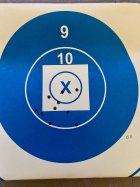
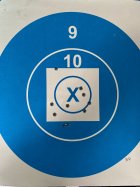
CharlieNC
Gold $$ Contributor
Positive compensation. Often referred to, and demonstrated in an excellent article by Kolbe, exhibiting how a rimfire tuner to properly dial in the harmonic exit time offsets the velocity differences. We use charge weight to accomplish this via a ladder on the target.
Similar threads
- Replies
- 32
- Views
- 2,830
Upgrades & Donations
This Forum's expenses are primarily paid by member contributions. You can upgrade your Forum membership in seconds. Gold and Silver members get unlimited FREE classifieds for one year. Gold members can upload custom avatars.

Click Upgrade Membership Button ABOVE to get Gold or Silver Status.
You can also donate any amount, large or small, with the button below. Include your Forum Name in the PayPal Notes field.
To DONATE by CHECK, or make a recurring donation, CLICK HERE to learn how.

Click Upgrade Membership Button ABOVE to get Gold or Silver Status.
You can also donate any amount, large or small, with the button below. Include your Forum Name in the PayPal Notes field.
To DONATE by CHECK, or make a recurring donation, CLICK HERE to learn how.










